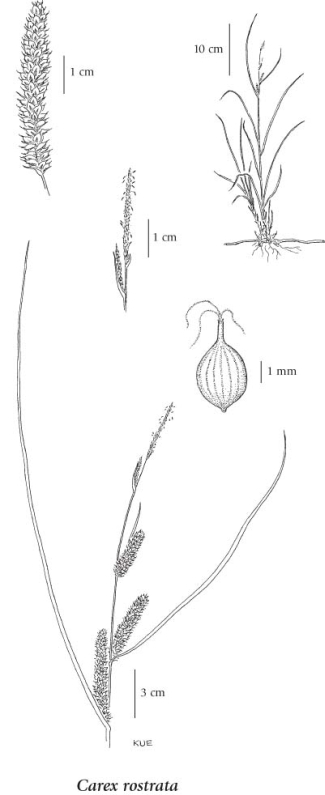swollen beaked sedge (beaked sedge)
Cyperaceae (Sedge family)
Introduction to Vascular Plants
Species Information click to expand contents
General:
Perennial, tufted herb from short-creeping rhizomes; stems 30-70 cm tall, triangular, smooth, except slightly rough below the inflorescence, slightly longer than the leaves.
Leaves:
Sheaths tight; ligules as long as wide; blades 4 to 8 per stem, borne on the lower 1/2 of the stem, 1.2-4.5 mm wide, folded or channeled, with silica papillae on the upper surface, cross-walled; lower leaves reduced, persistent.
Flowers:
Spikes 3 to 6 (8), the terminal 1 or 2, sometimes 3 or 4, linear, 1.5-5 cm long, long-stalked, with many male flowers, the lower 2 to 4 spikes cylindrical, 3-6.5 cm long, with female flowers, short-stalked, the lowermost ones spreading; bracts subtending the lowest spike leaflike, sheathless, the lowest one longer than the inflorescence.
Fruits:
Perigynia egg-shaped, 5-9 mm long, 1.7-3 mm wide, yellowish-green to reddish-brown, somewhat inflated, smooth, shiny, strongly nerved, rather abruptly contracted into beaks, the beaks 1.5-2 mm long, bidentate, with straight teeth; female scales lanceolate to egg-shaped, pointed, rarely awned, narrower and shorter than the perigynia, yellowish- to chestnut-brown, with lighter centres and narrow, translucent margins; stigmas 3; achenes 3-angled, 2.5-3 mm long.
Illustration click to expand contents

If more than one illustration is available for a species (e.g., separate illustrations were provided for two subspecies) then links to the separate images will be provided below. Note that individual subspecies or varietal illustrations are not always available.
Illustration Source: The Illustrated Flora of British Columbia
USDA Species Characteristics click to expand contents
Flower Colour:
Brown
Blooming Period:
Late Spring
Fruit/Seed characteristics:
Colour: Brown
Present over the Summer
Source: The USDA
Ecology click to expand contents
The table below shows the species-specific information calculated from
original data (BEC database) provided by the BC Ministry of Forests and Range.
(Updated August, 2013)
| Site Information |
Value / Class |
||
|
Avg |
Min |
Max |
|
| Elevation
(metres) |
1089 | 850 | 1300 |
| Slope
Gradient (%) |
0 | 0 | 1 |
|
Aspect (degrees) |
0 | 45 | 135 |
| Soil
Moisture Regime (SMR) [0 - very xeric; 4 - mesic; 8 - hydric] |
5 | 4 | 8 |
| Modal
Nutrient Regime
Class |
B | ||
| #
of field plots species was recorded in: |
8 | ||
| Modal
BEC Zone Class |
ICH | ||
|
All BEC Zones (# of stations/zone) species was recorded in |
ICH(4), MS(1) | ||
|
Source:
Klinkenberg 2013
|
|||
Habitat and Range click to expand contents
Status Information click to expand contents
Synonyms click to expand contents
Synonyms and Alternate Names:
Carex ×anticostensis (Fernald) Lepage
Carex ×anticostensis var. inflatior Lepage (pro nm.)
Carex ×anticostensis var. longidens Lepage (pro nm.)
Carex ×anticostensis var. minor Lepage (pro nm.)
Carex grahamii Boott.
Carex mainensis Porter ex Britton
Carex rostrata var. ambigens Fernald
Carex rostrata var. anticostensis Fernald
Similar Species click to expand contents
Because Carex rostrata is rare (blue-listed) in British Columbia, it is important to be able to distinguish it from the common C. utriculata. With a few tips this can easily be done in the field and herbarium. The foliage of C. rostrata has a whitish-green to grayish blue-green appearance, and C. utriculata tends to be pale-green to green. These species often co-occur with C. rostrata preferring the wetter parts of a wetland and C. utriculata preferring the drier parts.
The whitish-green to grayish blue-green colour of C. rostrata seems to be caused by many tiny, tightly packed pimples (papillae) on the top (adaxial) side of the leaves. These papilla can only be seen with the aid of magnification strong enough (about 20-30X) to clearly see the tissue between the veins of the leaves (Fig. 2). The adaxial leaf surface of C. utriculata is usually smooth and green but may have some bumps (scabrous), however they do not affect the leaf morphology enough to alter the colour. In the absence of magnification these two species can still be discerned based on macro-morphological leaf characters. The leaves of C. rostrata are narrow (rarely up to 4.5 mm wide), broadly U-shaped in cross section; the margins are rolled up back toward the centre of the adaxial surface (involute); and the bottom (abaxial) side lacks a thin, short ridge running down its centre. The leaves of C. utriculata are broad (>4.5 mm wise), broadly gull-winged to flat in cross section, do not have involute margins, and the abaxial surface has a thin short ridge running down its centre. The Flora of North America has a very nice plate (Ball & Reznicek 2002, p. 505) that illustrates the leaf cross-section profile of C. utriculata and the papilla of C. rostrata very well. However, this plate does not show the involute margins of C. rostrata (Ball & Reznicek 2002, p. 505). Note Author: Chris Sears, Vegetation Biologist |